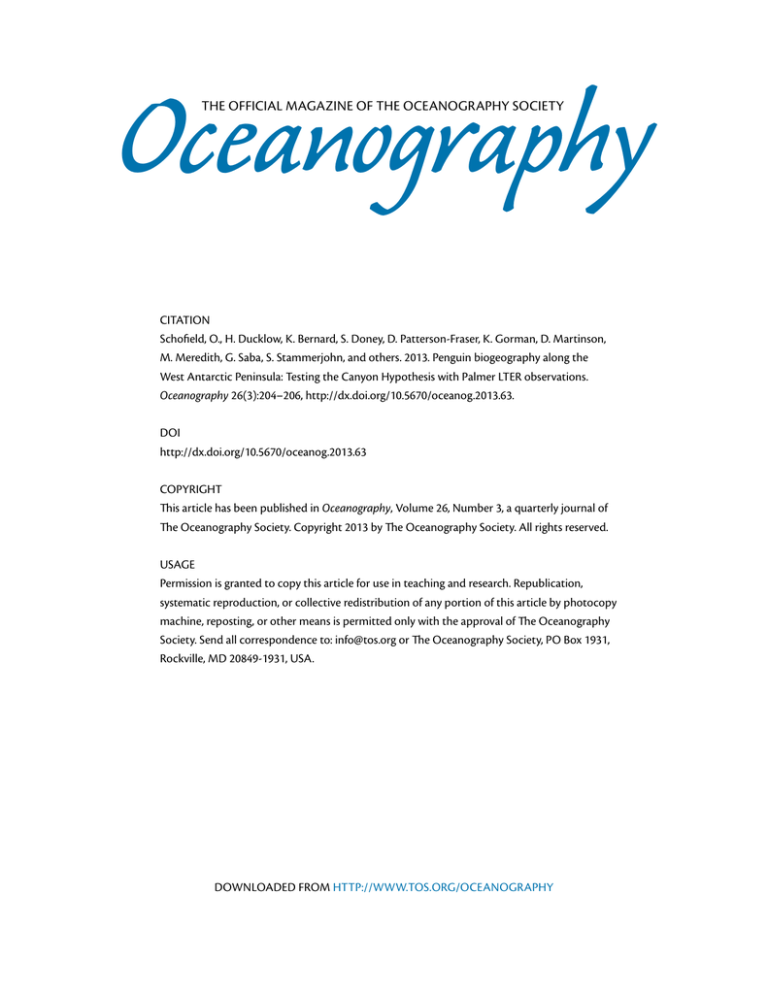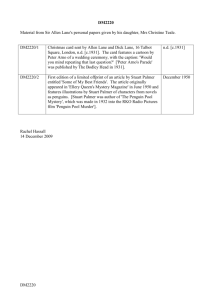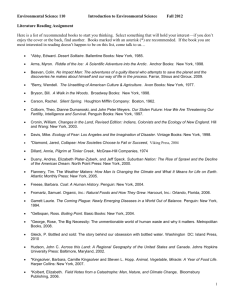
Oceanography
The Official Magazine of the Oceanography Society
CITATION
Schofield, O., H. Ducklow, K. Bernard, S. Doney, D. Patterson-Fraser, K. Gorman, D. Martinson,
M. Meredith, G. Saba, S. Stammerjohn, and others. 2013. Penguin biogeography along the
West Antarctic Peninsula: Testing the Canyon Hypothesis with Palmer LTER observations.
Oceanography 26(3):204–206, http://dx.doi.org/10.5670/oceanog.2013.63.
DOI
http://dx.doi.org/10.5670/oceanog.2013.63
COPYRIGHT
This article has been published in Oceanography, Volume 26, Number 3, a quarterly journal of
The Oceanography Society. Copyright 2013 by The Oceanography Society. All rights reserved.
USAGE
Permission is granted to copy this article for use in teaching and research. Republication,
systematic reproduction, or collective redistribution of any portion of this article by photocopy
machine, reposting, or other means is permitted only with the approval of The Oceanography
Society. Send all correspondence to: info@tos.org or The Oceanography Society, PO Box 1931,
Rockville, MD 20849-1931, USA.
downloaded from http://www.tos.org/oceanography
S p e c i a l Iss u e O n Co a s ta l Lon g T e r m E c o l o g i c a l R e s e a r c h
Penguin Biogeography Along
the West Antarctic Peninsula
Testing the Canyon Hypothesis with Palmer LTER Observations
B y O s c a r S c h o f i e l d , H u g h D u c k l ow , K i m B e r n a r d , S c o t t Don e y ,
Donn a P at t e r son - F r a s e r , K r i s t e n Go r m a n , Do u g M a r t i nson , M i c h a e l M e r e d i t h ,
G r a c e S a b a , S h a r on S ta m m e r j o h n , D e bo r a h S t e i nb e r g , a n d W i l l i a m F r a s e r
The West Antarctic Peninsula (WAP) is
home to large breeding colonies of the
ice-dependent Antarctic Adélie penguin
(Pygoscelis adeliae). Although the entire
inner continental shelf is highly productive, with abundant phytoplankton
and krill populations, penguin colonies
are distributed heterogeneously along
the WAP (Ducklow et al., 2013, in this
issue). This ecological conundrum targets a long-standing question of interest:
what environmental factors structure the
locations of Adélie penguin “hot spots”
throughout the WAP?
Penguin colonies appear to be located
in association with deep submarine
canyons that are found all along the
WAP continental shelf (Figure 1).
These deep troughs extend from the
shelf break to the land margin. Marine
canyons are hypothesized to provide a
cross-shelf conduit for warm (> 1°C),
modified, Upper Circumpolar Deep
Water to the coast. This water mass is
the primary heat source within the WAP,
and the observed warming of Upper
Circumpolar Deep Water (Martinson
204
Oceanography
| Vol. 26, No. 3
et al., 2008) is driving regional atmospheric warming (Ducklow et al., 2012)
and the observed declines in sea ice in
this region (Stammerjohn et al., 2008).
In the past, when annual and perennial
sea ice dominated these coastal waters,
canyons were hypothesized to drive the
recurrent formation of polynyas (areas of
open water surrounded by sea ice) that
provided penguins year-round access
to open-water foraging areas. Proximity
of reliable foraging areas to breeding
colonies is important given the energy
costs for breeding parents needing to
travel to forage and return to provision
and protect chicks.
Close association of major WAP
penguin colonies with marine canyons
led to a long-standing hypothesis that
unique physical and biological processes
induced by these canyons produce
regions of enhanced prey availability
that are predictable over ecological time
scales (decades to centuries). Linking
the regional physical and ecological
dynamics to test the “canyon” hypothesis
has in the past been restricted by harsh
environmental conditions that limit
Zodiac and ship sampling. However, the
Palmer Long Term Ecological Research
(LTER) network recently expanded its
observational efforts by incorporating
autonomous underwater sampling and
satellite tagging of penguins to increase
sampling capabilities at two large Adélie
penguin colonies along the WAP.
Anvers Island is a focal site of
Palmer LTER efforts (Figure 1). Here,
Palmer Deep is a cross-shelf canyon
bathymetrically similar to others in the
WAP that are also associated with large
penguin populations. Satellite-tagged
Adélie penguins breeding at Anvers
Island appear to forage exclusively within
Palmer Deep. A majority of Adélie foraging activity is centered over the canyon
edge where the bathymetry rapidly
shoals, and around which the spatial
variability in foraging is strongly influenced by tides (Oliver et al., 2013). These
foraging patterns were used to guide
sampling of physical and biological properties using autonomous Webb Slocum
gliders. Gliders revealed the uplift of
Figure 1. The 1,000 km sampling domain of the Palmer Long Term Ecological Research (LTER) program. (A) Bathymetry of the spatial sampling domain of
the Palmer LTER. Orange arrows indicate the Antarctic Circumpolar Current and potential transport to coastal regions. Arrows with question marks indicate
hypothesized routes requiring more data. Penguin breeding colonies are indicated by the paired-penguin symbols. For three of the penguin colonies (outlined
in red), subsurface data have been collected with an effort to identify the presence of warmer deep waters of the modified Circumpolar Current near the penguin colonies. (B) Slocum glider temperature data collected offshore Palmer Station and its resident penguin colonies, showing the uplift of warm water along
the canyon. (C) Glider temperature and penguin foraging data, collected by radio-tags at Avian Island near Rothera Station. The foraging locations are indicated by the surface purple shadow. It is associated with areas where warm water occurs at both surface and at depth. (D) Two temperature profiles measured
by ship over the seafloor canyon adjacent to the penguin colony at Charcot Island, showing warm water at depth consistent with the presence of modified
Upper Circumpolar Deep Water.
warm deep water along the slope of the
canyon (Figure 1B), a hydrographic feature associated with enhanced concentrations of phytoplankton. Furthermore,
glider-based measurements of phytoplankton health using a bio-optical
measure, Fv/Fm, the quantum yield for
photosystem II activity (Falkowski and
Raven, 2007), indicated algal cells at the
canyon edge were the healthiest in the
region. Net tows and acoustic survey
data indicate the presence of abundant
krill near the canyon slope.
A second major Adélie breeding
colony is located on Avian Island in
Marguerite Bay (Figure 1), where
chlorophyll and krill concentrations
are high. Based on available satellite tag
data, penguin foraging is concentrated
on the southern flank of Avian Island
(Figure 1C). This region is located near
the seafloor canyon at the mouth of
Marguerite Bay, where gliders revealed
shoaling of warm bottom water. In contrast, on the inner reaches of Marguerite
Bay by Rothera Base, gliders revealed
high chlorophyll but no shoaling of
warm bottom water. Penguin foraging
does not appear to be significant at the
inshore location, further suggesting the
importance of warm deep water for foraging at Adélie colonies.
As the WAP warms, it might be
expected that conditions surrounding breeding colonies in the south may
become more favorable as sea ice and
perennial land-fast ice continues to
decline. This situation motivated the
Palmer LTER program to expand its
regional sampling grid to the south.
Charcot Island, newly accessible following the collapse of the Wilkins Ice Shelf
Oceanography
| September 2013
205
in 2008, borders the southern boundary
of the new Palmer LTER regional grid.
During our first exploration in 2009,
the Palmer LTER team conducted only
the third known landing on Charcot
Island in the last century. We discovered the continued presence of a rarely
documented breeding colony of Adélie
penguins (Henderson, 1976). Consistent
with our canyon hypothesis, a previously
unmapped 800 m deep seafloor canyon
was discovered adjacent to the penguin
colony. Conductivity-temperaturedepth (CTD) profiles within the canyon
revealed warm (> 1.2°C) water at depth
(> 200 m), consistent with the presence of modified Upper Circumpolar
Deep Water (Figure 1D). The canyon
was first located by the presence of a
polynya, consistent with the hypothesis
that canyons result in predictable access
to open water for penguin foraging.
Shipboard measurements at the Charcot
Island canyon revealed high concentrations of phytoplankton, bacteria, and
krill. Satellite tags confirmed penguin
foraging near the canyon. Subsequent
visits also confirmed the sustained presence of the Charcot penguin colony;
however, poor-quality bathymetric data
requires future surveying to map the link
between the nearshore seafloor canyon
and the outer shelf. We discovered that
navigational charts have Charcot Island
misplaced by 5 km in this previously
inaccessible region.
In conclusion, major WAP Adélie
penguin colonies appear to be located in
close proximity to the heads of seafloor
canyons (although the presence of seafloor canyons does not assume an association with a penguin breeding colony).
This connection may in part reflect that
marine canyons can provide a conduit
Oscar Schofield (oscar@marine.rutgers.edu) is Professor, Coastal Ocean Observation
Laboratory, Institute of Marine and Coastal Sciences, School of Environmental and
Biological Sciences, Rutgers University, New Brunswick, NJ, USA. Hugh Ducklow is
Professor, Lamont-Doherty Earth Observatory of Columbia University, Palisades, NY,
USA. Kim Bernard is Assistant Professor, College of Earth, Ocean, and Atmospheric
Sciences, Oregon State University, Corvallis, OR, USA. Scott Doney is Senior Scientist,
Marine Chemistry & Geochemistry Department, Woods Hole Oceanographic Institution,
Woods Hole, MA, USA. Donna Patterson-Fraser is a seabird ecologist at the Polar Oceans
Research Group, Sheridan, MT, USA. Kristen Gorman is a researcher with the Polar
Oceans Research Group, Sheridan, MT, USA, and a PhD candidate in the Department
of Biological Sciences, Simon Fraser University, Burnaby, BC, Canada. Doug Martinson
is Doherty Senior Research Scientist, Lamont-Doherty Earth Observatory of Columbia
University, Palisades, NY, USA. Michael Meredith is Science Leader, British Antarctic
Survey, Cambridge, UK, and Honorary Professor, Scottish Association for Marine Science,
Oban, UK. Grace Saba is Assistant Research Professor, Coastal Ocean Observation
Laboratory, Institute of Marine and Coastal Sciences, School of Environmental and
Biological Sciences, Rutgers University, New Brunswick, NJ, USA. Sharon Stammerjohn
is Assistant Adjunct Professor of Ocean Science, Institute of Arctic and Alpine Research,
University of Colorado, Boulder, CO, USA. Deborah Steinberg is Professor, Virginia Institute
of Marine Science, College of William & Mary, Gloucester Pt., VA, USA. William Fraser is
President and Lead Investigator, Polar Oceans Research Group, Sheridan, MT, USA.
206
Oceanography
| Vol. 26, No. 3
for warm Upper Circumpolar Deep
Water near the coast. Taken together,
these results emphasize the importance
of geology in structuring the spatial heterogeneity of ecosystems.
Acknowledgements
Palmer LTER is supported by NSF grant
OPP-0823101 and the Gordon and
Betty Moore Foundation (1859). Some
of the data for this paper was drawn
from the Rothera Time-Series (RaTS),
a component of the Polar Oceans
research program, funded by the British
Antarctic Survey.
Reference s
Ducklow, H., A. Clarke, R. Dickhut, S.C. Doney,
H. Geisz, K. Huang, D.G. Martinson,
M.P. Meredith, H.V. Moeller, M. Montes-Hugo,
and others. 2012. Marine pelagic ecosystems:
The West Antarctic Peninsula. Pp 121–149
in Antarctica: An Extreme Environment in a
Changing World. A.D. Rogers, ed., Wiley.
Ducklow, H.W., W.R. Fraser, M.P. Meredith,
S.E. Stammerjohn, S.C. Doney, D.G. Martinson,
S.F. Sailley, O.M. Schofield, D.K. Steinberg,
H.J. Venables, and C.D. Amsler. 2013. West
Antarctic Peninsula: An ice-dependent
coastal marine ecosystem in transition.
Oceanography 26(3):190–203, http://
dx.doi.org/10.5670/oceanog.2013.62.
Falkowski, P.G., and J.A. Raven, 2007. Aquatic
Photosynthesis. Blackwell Scientific Publishers,
Oxford.
Henderson, I. 1976. Summer log of travel and work
of sledge kilo in northern Alexander Island and
Charcot Island, 1975/1976. British Antarctic
Survey internal report ref. T/1975/K11.
Martinson, D.G., S.E. Stammerjohn, R.A. Iannuzzi,
R.C. Smith, and M. Vernet. 2008. Western
Antarctic Peninsula physical oceanography and
spatio-temporal variability. Deep Sea Research
Part II 55:1,964–1,987, http://dx.doi.org/
10.1016/j.dsr2.2008.04.038.
Oliver, M.J., A. Irwin, M. Moline, W. Fraser,
D. Patterson, O. Schofield, and J. Kohut. 2013.
Adélie penguin foraging location correlated
to local tides. PLoS ONE 8(1):e55163, http://
dx.doi.org/10.1371/journal.pone.0055163.
Stammerjohn, S.E., D.G. Martinson, R.C. Smith,
and R.A. Iannuzzi. 2008. Sea ice in the
western Antarctic Peninsula region: Spatiotemporal variability from ecological and climate change perspectives. Deep Sea Research
Part II 55:2,041–2,058, http://dx.doi.org/
10.1016/j.dsr2.2008.04.026.




